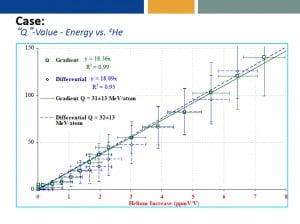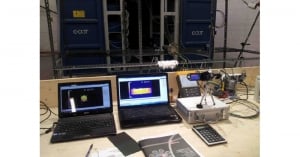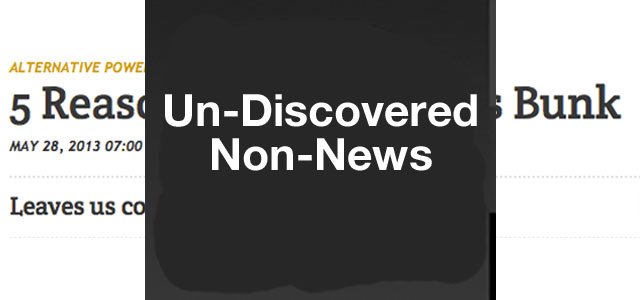The recent article 5 Reasons Cold Fusion is Bunk published on Discovery.com News continues the misinformation and serious inaccuracies that make clear mainstream media’s ignorance of a new discovery that offers a solution to our energy problems.
The article does not clearly discern the five distinct reasons that cold fusion cannot occur, but objections appear to be the same criticisms heard for two-and-a-half decades: cold fusion does not fit the conventional nuclear theory of hot fusion developed one hundred years ago, and therefore it cannot occur.
Sources for the article are astrophysisist Ethan Siegel, who does not accept the two-and-a-half-decades research documenting anomalous effects from deuterated systems, and known Rossi-detractor Steven Krivit, Editor of New Energy Times, who actively campaigns against E-Cat HT technology.
Taken one at a time, the “reasons” given that cold fusion cannot occur are:
Inaccuracy 1 Fusion of two elements requires high-temperatures and pressure, like the conditions inside the Sun, to overcome the Coulomb barrier, the force that keeps like-charged nucleons apart.
This statement is true for hot fusion, which has spent untold billions on attempting to re-create the conditions of the Sun here on Earth, without successfully generating any usable power.
The statement is not true of cold fusion.
“The circumstances of cold fusion are not the circumstances of hot fusion”, said Nobel laureate Julian Schwinger.

In experiments were palladium is infused with deuterium (Pd-D), the resulting reaction produces heat and helium. This has been documented by scientists from California Polytechnic Institute, the Navy’s China Lake research lab, and SRI International in Menlo Park, California.
This is not a likely reaction pathway that occurs in hot fusion, and yet, it occurs almost exclusively in Pd-D. Whether your vocabulary is low-energy nuclear reactions (LENR), lattice-assisted nuclear reactions (LANR), quantum fusion, or the Anomalous Heat Effect (AHE), the result does not change; put in deuterium and you can generate helium.

Increasing the temperature, as in Andrea Rossi‘s E-Cat HT and Defkalion’s Hyperion, also create movement in the system.
There are many discoveries and hypotheses today that are absurd on the face of it, yet people accept them without second thought. The idea that two particles can join together in a solid material through resonance by a nuclear mechanism we have yet to understand should not be a difficult concept, that is unless you have a vested interest in not seeing this technology come to light.
Inaccuracy 2 Fusion is always accompanied by dangerous radiation.
This statement is true of hot fusion as modeled by the Standard Model of nuclear reactions from one-hundred years ago.
It is not true of cold fusion.
Cold fusion cells sometimes emit radiation, depending on the type of design.
Radiation from cold fusion cells is 11 million times less than hot fusion. Some systems emit no radiation at all.
The Pd-D systems cited above emit only helium. In all cases, the radiation is so little, scientists must work hard to even detect it.
Indeed, the lack of radiation is what makes cold fusion the ultra-clean energy-dense solution for a green technological future on Earth.
The sources for this article compare cold fusion with the theory of hot fusion, a mistake the conventionally-minded make when they do not review the literature and refuse to accept the experimental data. It is a perplexing scientific question, and needs the full community to solve it.
Inaccuracy 3 Transmutation of nickel to copper cannot occur at room-temperature, in condensed matter.
Researchers at the University of Chicago Urbana-Champagne, University of LaVerne, at Mitsubishi in Japan, at labs in France, among others around the world, have all have detected a host of elements generated by their LENR cells.
In the Ukraine, Vladimir Vysotskii has reported biological transmutations, whereby a bacteria absorbs radioactive cesium and transmutes it into other benign materials, research which may lead to a process that can rid the planet of the thousands of tons of radioactive waste.
Reports of copper in both Pd-D and Nickel-Hydrogen Ni-H systems, as well as other elements not present before the experiment, have been reported by numerous scientists in the field causing some to use a new name for this particular research avenue: low-energy nuclear transmutations (LENT).
Inaccuracy 4 The intimation that there was a secret, hidden power source during the E-Cat testing of which the scientists were unaware, or if aware, in collusion with each other, to create the observed power output.

Such accusations should address what these scientists would have to gain from this association, in either case.
The scientists who tested the unit were:
Giuseppe Levi, Bologna University, Bologna, Italy
Evelyn Foschi, Bologna, Italy
Torbjorn Hartman, Uppsala University, Uppsala, Sweden
Bo Hoistad, Uppsala University, Uppsala, Sweden
Roland Pettersson, Uppsala University, Uppsala, Sweden
Lars Tegner, Uppsala University, Uppsala, Sweden
Hanno Essen, Royal Institute of Technology, Stockholm, Sweden
Continuing to attack the capability or veracity of this group is reprehensible.
Inaccuracy 5 Rossi has not divulged his secret catalyst that makes the E-Cat produce such big heat because he is hiding a fraudulent claim.
It is true that the scientists who conducted the tests were unable to inspect the proprietary fuel mixture inside the inner-cartridge.
However, as a black box, where all other inputs and outputs were known and measured, it was clear to the authors of the test report that the reactor made a lot of excess heat.
Whatever the 0.3 grams nickel-powder mixture inside, the E-Cat HT energy density was off-the-chart.
Rossi’s proprietary mixture of fuel is his secret alone, which he will likely have to share for a U.S. patent. If he chooses to produce marketable devices without a patent, then he will be attempting to stay ahead of the competition by driving innovation and price.
Nevertheless, the fact that there is secrecy involved in a revolutionary new energy technology is not surprising. Each of the independent labs and small companies working on a commercial device have their own proprietary element, though none have yet achieved (as far as we know) the kind of big heat, and/or or the stability and control demanded for a usable product.
What you can do
Discovery.com is part of Discovery Communications which appears to operate websites for the Discovery Channel, the Science Channel, Discovery Magazine, and surprisingly, the Oprah Winfrey Network!
Their magazine has published material on the Widom-Larsen Theory of cold fusion, which has not been confirmed (no definitive theory of cold fusion exists yet). Their source continues to be only those who have negative views of the field, and I haven’t seen any positive LENR pieces on the Science channel. (Let me know if you do!) The battle with misinformation will continue until a commercial product is available for purchase, or, a theory of cold fusion is confirmed.
Until then, let’s ask Oprah to turn her empire towards a green energy solution.
Post your request on Do You Have an Idea for Lisa Ling?
Our family is in trouble, and we could use some help.
Cold Fusion Now!


